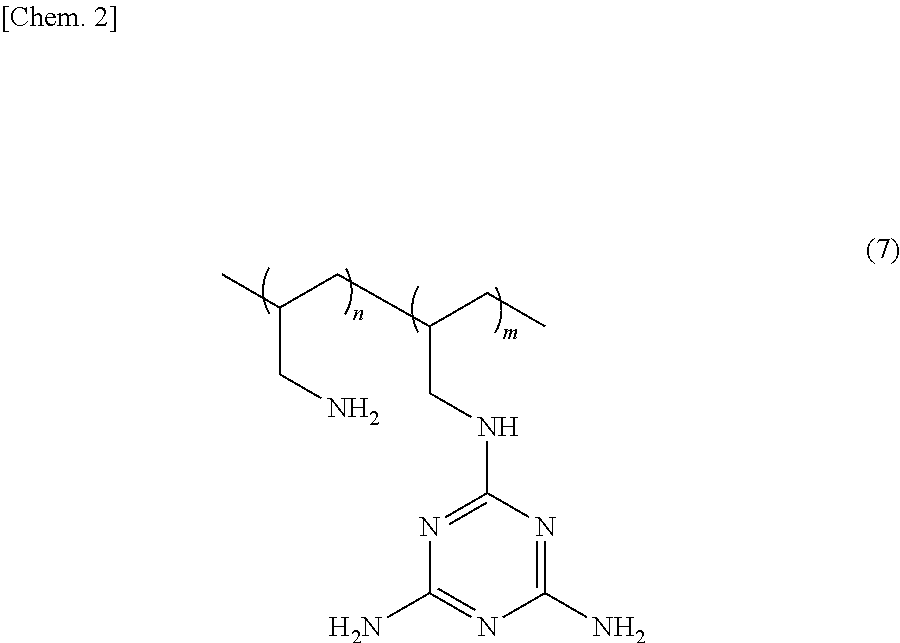Polymer capable of adsorbing acidic water-soluble target substance, and method for production of the polymer
a polymer and target substance technology, applied in the field of polymer capable of adsorption of acidic water-soluble target substance, can solve the problems of markedly difficult preparation and use of mip in water, reducing the specific binding ability of mip template molecule, and difficult to prepare an mip for a water-soluble compound in an organic solvent, etc., to achieve suppress the reduction of blood nutritive components, improve the adsorption effect, and reduce the burden on social activities
- Summary
- Abstract
- Description
- Claims
- Application Information
AI Technical Summary
Benefits of technology
Problems solved by technology
Method used
Image
Examples
##ventive example 1-1
Inventive Example 1-1
[Preparation of Polymer Solution]
[0096]In a screw glass test tube, 36.0 mg (0.21 mmol) of uric acid (Sigma Aldrich) was added to 1.2 ml of an aqueous solution of polyallylamine having a molecular weight of 15,000 (total amount of amino groups per 1 g, 17.5 mmol) (mfd. by NITTO BOSEKI) (PALA 15) prepared into 10% by mass (amino group 2.14 mmol), thereby dissolving uric acid. Thereafter, a polymer solution was prepared by bubbling nitrogen gas for 5 minutes.
[Michael Addition Reaction]
[0097]A cross-linker solution was prepared by dissolving 416.4 mg (2.14 mmol) of N,N′-bisacryloylpiperazine (Sigma Aldrich) and 2.9 mg (0.017 mmol) of 2,2′-azobis(2-amidinopropane)dihydrochloride (Sigma Aldrich) in 2.7 ml of water and bubbling nitrogen gas for 5 minutes. The cross-linker solution was added to the polymer solution described in the above and stirred as such for 30 seconds. After completion of the stirring, the first stage cross-linking reaction by the Michael addition r...
##ventive example 1-2
Inventive Example 1-2
[0100]Polymer particles were obtained in the same manner as in Inventive Example 1-1 except that uric acid was not blended.
reference example 1-1
[0105]Commercially available activated carbon (mfd. by Aldrich; particle size 2 to 12 μm).
[Evaluation of Uric Acid Adsorbing Performance]
[0106]A 10 mg portion of particles of each of Inventive Examples 1-1 and 1-2, Comparative Examples 1-1 and 1-2, and Reference Example 1-1 were added to 1 ml of 1 mmol / l of brine containing 0.2 mmol / l of uric acid (Sigma Aldrich). After 16 hours of incubation at room temperature, liquids to be tested were obtained by centrifugation (4,000 rpm, 10 minutes, room temperature). By measuring the absorbance at 290 nm characteristic to uric acid using a spectrophotometer (Beckman Coulter, DU 800) on each obtained liquid to be tested, residual uric acid was determined, and adsorbed amount of uric acid was calculated from the result. The results are shown in Table 1.
[0107]As is evident from Table 1, due to formation of a specific recognition site for uric acid in the polymer by the molecular imprinting method and a two-step reaction (Michael addition reactio...
PUM
| Property | Measurement | Unit |
|---|---|---|
| diameter | aaaaa | aaaaa |
| molecular weight | aaaaa | aaaaa |
| molecular weight | aaaaa | aaaaa |
Abstract
Description
Claims
Application Information
 Login to View More
Login to View More - R&D
- Intellectual Property
- Life Sciences
- Materials
- Tech Scout
- Unparalleled Data Quality
- Higher Quality Content
- 60% Fewer Hallucinations
Browse by: Latest US Patents, China's latest patents, Technical Efficacy Thesaurus, Application Domain, Technology Topic, Popular Technical Reports.
© 2025 PatSnap. All rights reserved.Legal|Privacy policy|Modern Slavery Act Transparency Statement|Sitemap|About US| Contact US: help@patsnap.com



